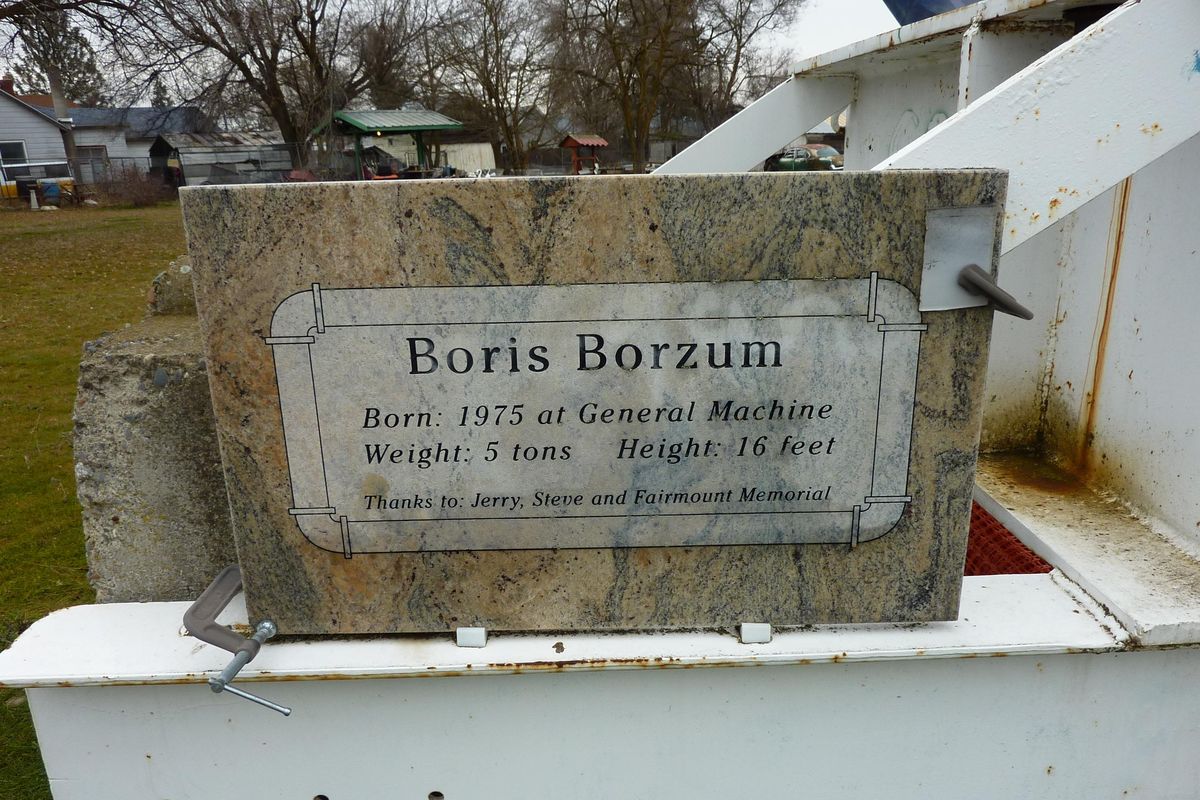Landmarks: Lend ‘The Big Man’ a hand – Plane replica sought for Boris Borzum statue

There is a 16-foot tall metal man in Spokane in need of a replica airplane.
Boris Borzum (aka The Big Man) stands on the corner of College Avenue and Summit Boulevard on the western edge of Spokane’s West Central neighborhood, overlooking the Spokane River and gazing off into the distance toward the planes approaching Spokane International Airport. Arms over his head, he’s missing his right hand – the perfect place to attach a plane of his own, according to Kay Howard, on whose property Boris resides.
If only she had just the right plane. She’s been looking now for years – metal or wood, it doesn’t matter. Fighter plane, airliner, crop duster – also not important. She’d just like to locate one with at least a 4-foot wing span.
Here’s Boris’s story, according to Howard: The giant, 5-ton man, made mostly of steel, was created in 1975 for Wally Taylor, owner of Empire Boring, a local company that did horizontal underground drilling for the installation of pipe, conduit and cables, including many projects in the state, such as a major one at the Indian John Hill Rest Stop on Interstate 90 west of Ellensburg. Boris stood as a highly visible promotional symbol at the company’s location on Barker Road in Spokane Valley and later near Felts Field on Trent Avenue, and his image was on the company’s hat.
Howard still has one of the hats, which shows Boris as he once was – with his right hand holding a pipe with a boring bar through it. Over time, the pipe and boring bar were removed and put into use. By the time Boris made his way to Howard’s property, the hand was gone, too.
Howard and her husband, Don, were good friends with Taylor, as well as with Jerry Shoemaker, company foreman, who served in the same capacity after the company’s assets were purchased by Tunnel Systems of Monroe, Washington, in the late 1990s. In 2010, Tunnel Systems centralized operations out of its west-side headquarters, leaving Shoemaker with a big problem – what to do with Boris.
“Jerry was over at the house having dinner with Don and me,” Howard said, “and I blurted out, ‘just bring him over here.’” The next day, Boris was unbolted from his base and everything loaded up. Company trucks and crane arrived to put the base in place, secure it with two 2,500-pound cement blocks, and Boris was lifted over the fence to be re-bolted in place again at his new home.
“Within a week, people were stopping by to take his picture,” Howard said. “I met people from Australia, Europe, South America. Even now, a day doesn’t go by when someone doesn’t stop to look at him. There was even a day when 18 motor scooters were lined up outside the fence.”
The Howards and Shoemaker tried to figure out what to make of Boris, now that he was retired. They thought to restore a hand with fingers raised in a victory sign, but they were afraid that vandals would remove one of the two upraised fingers. They considered putting on a top hat and decking him out like Uncle Sam. In the end, they just let him be.
Howard did get a piece of granite from neighbor Steve Tslueger, who had several scrap pieces in his yard, and “the nice people at Fairmount Memorial Association did the engraving on it for us.” So now Boris has a plaque at his base giving his vital statistics.
Three things remain to be told about Boris – how he got his name, why an airplane is needed and what’s he up to these days.
Apparently Taylor, who died in the early 2000s, created the first and last name as variations on the word “boring,” the company’s business. Howard noted that Taylor had a terrific sense of humor and listed his phone number in the phone book under Boris’s name. “This was so that when a caller asked for Boris, he knew it wasn’t someone he knew and just wanted to sell him something.”
Because Taylor and Shoemaker, who died a few years ago, were pilots and because Boris kind of keeps an eye on planes coming in for a landing at Spokane International, Howard said, “a plane just feels right,” especially if she can arrange for it to move with the wind.
And as for what’s upcoming for Boris, the answer is Bloomsday in May. He’s not exactly a runner, but he is sort of an official participant. Back in 2012 Don Kardong, founder of Spokane’s famous timed road race, sent Boris an oversized runners ID, which Howard had laminated.
So on Bloomsday this year 76-year-old Howard will again set up her ladder, climb up and put The Big Man’s runners’ number on him.
“But if he ever actually takes off with it, I’m outta here!”